The number of veterinary emergencies picked up in October compared to the previous two months
The number of veterinary emergencies picked up in October compared to the previous two months. We started the month by moving ten black rhinos from Ngulia sanctuary in Tsavo West national park and free releasing them in the rhino valley about 5Km from the sanctuary. The reason behind the relocation was to de-stock the sanctuary which with an estimated 70 rhinos has beyond its carrying capacity. The competition for resources (water, browse and space) had resulted to underperformance of the rhinos in terms of body scores and recruitment rates. There was also intra-species territorial fighting by males. The ration of males to females is estimated at 3:1. Five males and five females were captured and released in the valley where there is abundant browse and water. Rhinos were said to have thrived in the area before the poaching menace of the 60s and 70s completely decimated them. The capture entailed darting identified candidates from a helicopter followed by recovery and loading the rhinos into transport trucks. The valley has been declared a Rhino Intensive Protection Zone (IPZ) and provided with maximum security and an intensive monitoring and surveillance program to keep off any threats to the survival of the rhinos. All the rhinos were fitted with horn transmitters that send a signal to a receiver. This will aid monitoring from both the air and the ground. Clean animals (those without ear notches) were ear notched with a unique ear pattern that will aid in monitoring. Each rhino was also fitted with a transponder whose identity was noted and recorded. The transponders will also aid in identification of each specific rhino. 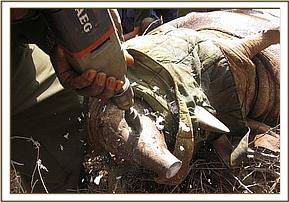


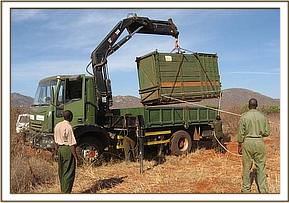
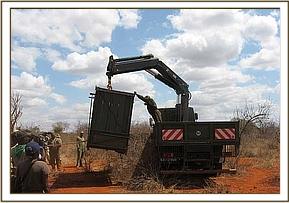
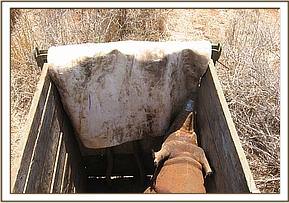

In the reporting period, we also had three animals treated with snares. The first was an eland near Voi Safari Lodge found too exhausted after struggling to free itself from a snare such that it did not require chemical immobilisation. It was restrained physically and the snare removed. It had no injury and the neck was found to be intact. Several minutes after, it regained strength and escaped into the bushes. 
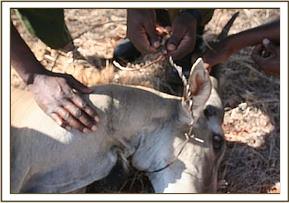
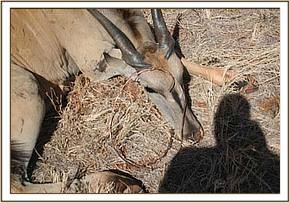

The other animal with a snare was an elephant aged about 20 years at Taita Hills sanctuary (Salt Lick). The snare was deeply embedded on the lower right hind leg inflicting a deep injury that was very infected. The animal was immobilised, the snare removed and the injury cleaned and treated topically. High doses of a systemic long acting antibiotic (Amoxicillin) were administered intramuscularly at different sites. The sanctuary management promised to monitor and relay progress to the Unit. At the time of preparing this report however, there had been no further sighting. The prognosis for recovery is favourable.
The last animal with a snare was also an elephant but this time a calf aged about 1½ years also at Salt Lick. The snare was loose around the neck. 


During the month we rescued five elephants aged between 4 months and 5 years. The first was aged about 4months and was found having fallen into a manhole along the Mzima water pipeline in Tsavo West. There was marked disturbance around the area by elephants, evidence that the family attempted to retrieve it before giving up and leaving the area. We did not see any elephants in the vicinity. We successfully retrieved the calf and it was airlifted to Nairobi where it is so far doing well.
The second aged about 3 years was rescued near Bachuma in Tsavo East on 11th October. It had narrow penetrating wounds on the lower fore legs, the hindquarters and the neck possibly inflicted by a high velocity object like a bullet. The injuries were heavily infected and the body condition was very poor. According to reports, the animal was being seen in the general area for over two weeks before the report was made. It seemed to have been left behind by the family after it failed to keep pace because of the injuries. Treatment was administered and the calf moved to the Voi elephant stockades for observation and repeat treatment. Another treatment was made on 14th October when the infections were found to have cleared significantly. The wounds on the hindquarters and the neck had very little pus discharges. However, the ones on the legs were still discharging pus. All the wounds were cleaned and infused with an antibiotic ointment and a systemic antibiotic was also administered.
During the observation period the animal remained weak and there was no improvement in the body condition. It refused to eat supplements provided to it but fed on browse only. It took water only sparingly and with time it developed constipation and would pass small pieces of hard faeces with difficulties. Another round of a systemic antibiotic was administered on the 25th October. By this time, the animal had resumed full use of the legs including the right fore which was most affected. However for unknown reasons but possibly related to dehydration for not taking water, the calf continued to deteriorate. Attempts to give it water from a bottle were risky for it was not used to handlers. It finally succumbed on the 28th October. Post-mortem did not reveal any incriminating cause of death. The only findings were Helminthosis and presence of Gasterophilus larvae (also called horse bots) in the stomach. Horse bots are larvae of bot flies (Gasterophilus spp) which spend part of their larval stages in the digestive tracts of herbivores. They attach to the stomach lining by oral hooks. This induces erosions and ulcerations at attachment sites and hyperplastic reactions around the sites. Bots cause mild gastritis but large numbers may be present with no clinical signs. Heavy infestations may however result to chronic gastritis, loss of condition and in rare cases perforations and deaths. The infestation in the present case was considered light and the reaction on the stomach wall was mild to have caused death. The dissection of the affected legs showed the infections to have cleared. 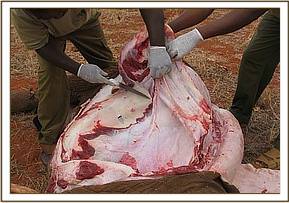

Another rescue was of a 2 year old at Tahri camp in Tsavo east. The calf was lame on its left hind leg which was thought to be due to a fracture that was in the process of uniting. There was an opening at the level of the injury that was oozing pus. The calf was immobilised and taken to the Voi elephant stockades where treatment was administered. A lot of white thick pus was drained from the injury and the opening was widened to create drainage for any other pus that would have accumulated after the treatment. It was also cleaned with hydrogen peroxide and water and infused with lugol’s iodine and an antibiotic ointment. A long acting antibiotic was also given intramuscularly. The calf was thereafter revived and released into the same enclosure with the calf described above. Unfortunately on the second day, the calf went down during the night and could not stand up even when supported. It thereafter succumbed and died upon which a post-mortem revealed a dislocated left knee. There were no other findings. 
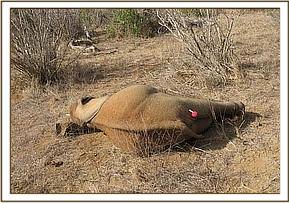


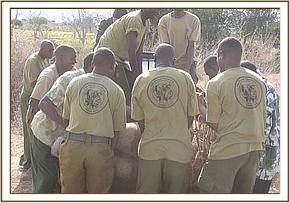
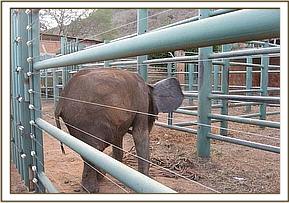

The fourth rescue was a 10 month old calf that was seen taking water alone at Satao camp watering hole on the 23rd October. By the time we reached the camp, we found the calf several metres from the watering hole down and unable to stand up. Our initial thinking was that it was suffering from hyperthermia because it was lying under direct sunlight with high ambient temperature. The body temperature was 39°C which was on the higher side. We therefore cooled it with copious amounts of water until the temperature went down. We thereafter loaded it onto an open pick-up truck and transported it to the elephant stockades at Voi where more supportive treatment was given that included an antibiotic and a corticosteroid (Dexamethasone) as well as water and a milk formula. The calf remained recumbent and never stood up. It died later that night. 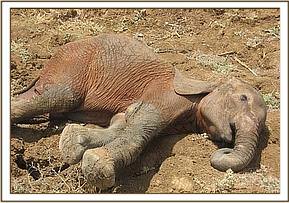
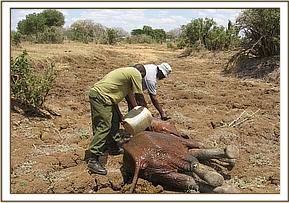
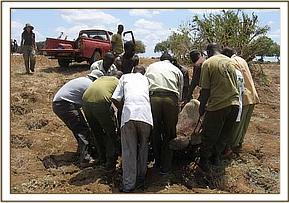
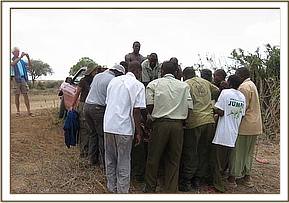

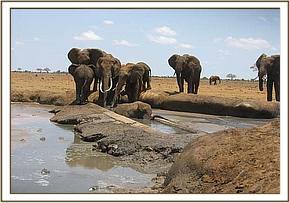

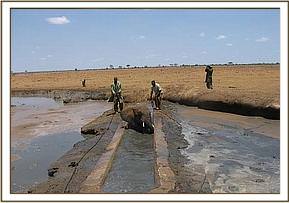


Just when we were through with the above elephant at the Aruba borehole and as we proceeded to do the autopsy on the dead calf, the manager Satao camp called to inform us of an elephant bull with an injury on the ventral abdomen taking water at the camp water hole. We proceeded to the camp and found the bull still at the water hole. It had a large piece of tissue hanging from the ventral abdomen. We did not however go straight to immobilise it because we arrived during the heat of the day when ambient temperature was very high and inappropriate to immobilise an animal because of risks of developing hyperthermia and associated complications. We therefore continued to monitor the animal until around 3.30pm. Upon immobilisation, we found an extensive injury on the ventral abdomen that was heavily infected. The cause was difficult to determine. Only the skin was involved, the abdominal muscles looked intact. It was cleaned thoroughly and treated topically with hydrogen peroxide and water. All necrotic tissues were trimmed. Thereafter, the injury was infused with lugol’s iodine and an antibiotic ointment. A high dose of a long acting antibiotic (amoxicillin) was given. We will continue to liaise with the camp manager to find out whether the bull will reappear again and enquire on progress. 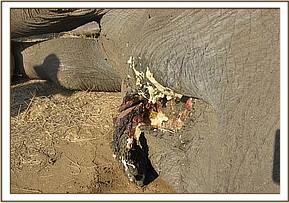

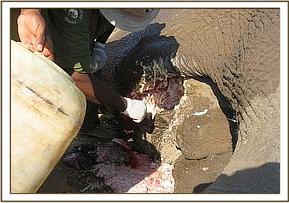
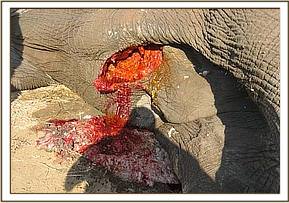
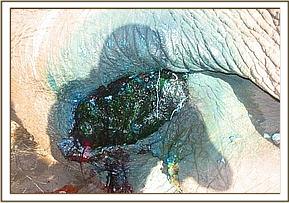
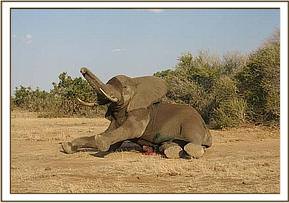

Other cases in the reporting period included an impala at Satao camp with a complete fracture of the right fore leg (upper radius) that was euthanised to stop further suffering. 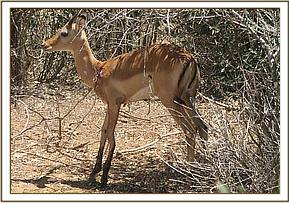
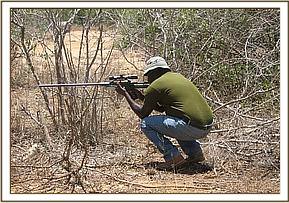

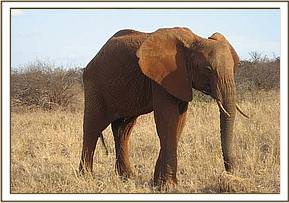
The elephant reported last month with a spear on the trunk in Amboseli has not reappeared yet. While the search for the 8-9 year old elephant treated at Kanderi in Tsavo east with an extensive injury on the right hind leg inflicted by a snare has also not yielded any fruits. We will continue with the search so that we can determine progress and give another treatment if found necessary.
During the reporting period, we also patrolled various parts of the areas under our jurisdiction. The parks remained dry and animals were concentrated in riverine habitats and the few remaining watering points. Diverse species were observed in good health status. A rinderpest surveillance exercise is scheduled to commence from the 30th October for three weeks. The exercise will entail immobilisation of susceptible species particularly buffaloes and collection of blood samples for serological analyses. Sero-surveillance of the disease in critical conservation areas with high interaction of wildlife and livestock is conducted periodically as part of the country’s contributions to global efforts to eradicate the disease by 2010. Wildlife having not been vaccinated before is an important sentinel (marker) of any infection that might be circulating.
Report by Dr. David Ndeereh
The Mobile Veterinary Unit operated by The David Sheldrick Wildlife Trust working with The Kenyan Wildlife Service and funded by Vier Pfoten